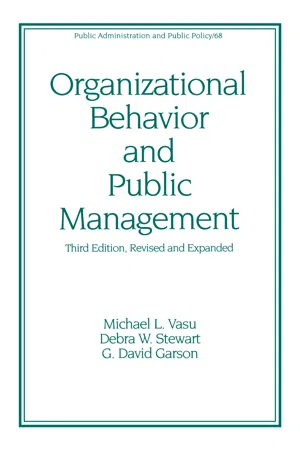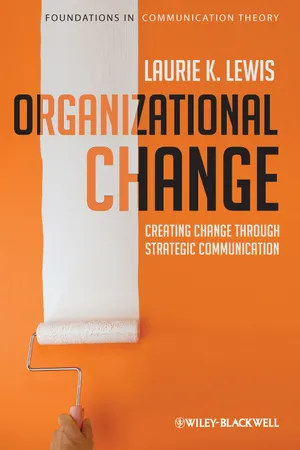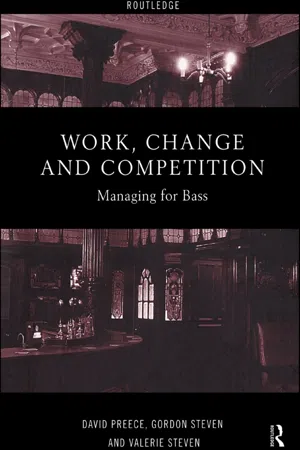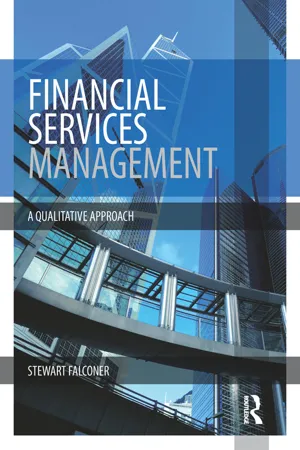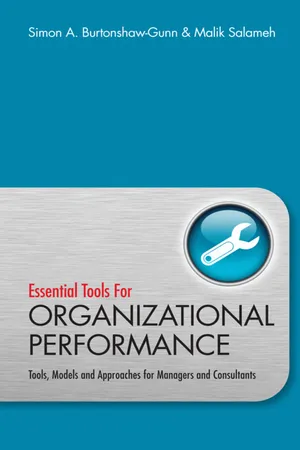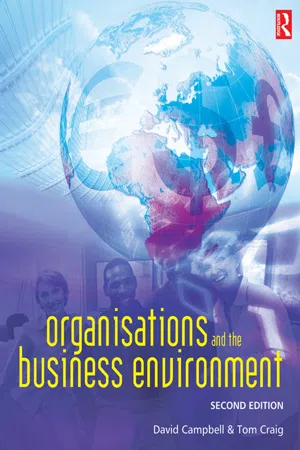Business
Organizational Change
Organizational change refers to the process of making significant alterations to an organization's structure, processes, or culture. It often involves implementing new strategies, technologies, or ways of working to improve performance, adapt to market conditions, or address internal challenges. Effective change management is crucial for ensuring successful implementation and minimizing resistance from employees.
Written by Perlego with AI-assistance
Related key terms
Related key terms
1 of 4
Related key terms
1 of 3
10 Key excerpts on "Organizational Change"
- Michael L. Vasu, Debra W. Stewart, G. David Garson(Authors)
- 2017(Publication Date)
- Routledge(Publisher)
9Organizational ChangeOrganizational Change refers to any significant alteration of the behavior pattern of a large number of the individuals who constitute an organization (Gabris, 1983; Heffron, 1989; Pasmore, 1994; Imai, 1997). For example, an organization that seeks to initiate Total Quality Management (TQM) is engaged, fundamentally, in Organizational Change. In today’s global economy, Organizational Change is frequently discussed within the context of what are called learning organizations, “organizations where people continually expand their capacity to create the results they truly desire, where new and expansive patterns of thinking are nurtured, where collective aspiration is set free, and where people are continually learning how to learn together” (Senge, 1990, p. 3). Learning organizations, in effect, are skilled at Organizational Change. To understand the nature of Organizational Change, managers need to look beyond human factors alone (Perrow, 1986; Taylor and Fe1ton, 1993; Imai, 1997). In this chapter, organizational culture and climate, as well as structure, technology and environment will all be represented in models guiding managers who successfully produce Organizational Change (Senge, 1990; Hofstede, 1991; Kochan and Useem, 1992; Osborne and Gaebler, 1992; Trice and Beyer, 1993; Imai, 1997). This chapter also outlines the critical elements of person-organization interface and proposes strategies which managers can employ to effect change within an organization. We proceed by defining each of the factors relevant to Organizational Change and then consider the actual change process, the type of organizational learning involved, and the strategies managers may adopt to help organizations change.Organizational Culture
Organizational culture is a subject of intense interest in both the popular and academic literature. There are a number of books on the topic; Peters and Waterman’s, In Search of Excellence; Ouchi’s, Theory Z; Pascale and Athos’s, The Art of Japanese Management , Schein’s, Organizational Cultures and Leadership; Hofstede’s, Cultures and Organizations;- eBook - ePub
Organizational Change
Creating Change Through Strategic Communication
- Laurie Lewis(Author)
- 2011(Publication Date)
- Wiley-Blackwell(Publisher)
experienced a vast array of change during a 12-month time frame: Merger, May 2006; Location or Condition changes, June 2006; Technology changes, October 2006; Responsibilities changes, October 2006; Restructuring, November 2006; Policy and Procedure changes, January 2007; new CEO, January 2007; the Acquisition, February 2007; and Pay and Bonus changes, May 2007. The lifespan of each of the changes was different, and additional changes within a change were also noted to occur (e.g., departments were restructured several times, new policies and procedures were continually released over several months). Source: Adapted from Laster (2008). Types of Organizational Change There are many ways of describing types of Organizational Changes. Here we will review three ways to categorize and conceptualize different change types. First, we can describe change as planned or unplanned. Keeping in mind that organizing activity is constantly in flux, we can still isolate periods of discernible disruptions to patterned activity. Planned changes are those brought about through the purposeful efforts of organizational stakeholders who are accountable for the organization’s operation. Unplanned changes are those brought into the organization due to environmental or uncontrollable forces (e.g., fire burns down plant, governmental shutdown of production) or emergent processes and interactions in the organization (e.g., drift in practices, erosion of skills). There is sometimes a fine distinction between planned change and planned responses to unplanned change. For example, the death of a founder CEO would count as an unplanned change but the processes involved in replacing that founder with a successor would be considered planned change. Major unplanned changes in the circumstances of organizations often require responses that are more than mere crisis intervention - eBook - ePub
Work, Change and Competition
Managing for Bass
- David Preece, Gordon Steven, Valerie Steven(Authors)
- 2002(Publication Date)
- Routledge(Publisher)
5 Change and changing
There are a number of matters which will be discussed in this main section. We will begin by distinguishing between what is meant by ‘change’ and ‘changing’; this is followed by an overview of ‘strategic’ or, as it is sometimes called, ‘planned’ change and some of the ways in which such change can begin. The foregoing necessarily draws upon a consideration of Organization Development (OD), and so something will be said here about the nature of OD, before addressing some of the main problems associated with this perspective on Organizational Change. Following this critique, the narrative moves away from OD to consider alternative frameworks for studying Organizational Change, labelled ‘emergent’ or ‘processual-contextual’. On the basis of this discussion of OD and Organizational Change, the narrative then turns to an examination of the people who take on a responsibility for change within organizations (‘change agents’).Clearly it is an impossible task to outline and discuss all the variety of forms which Organizational Change can take, such as cultural, structural, redesign of jobs, introduction of new working practices, changes to grading and remuneration systems, and changes to the modes of control. The nature and implications of any and all of these changes will vary both across different organizations and within the same organization over time. Given that the central focus of the book is upon a detailed outline and analysis of the many facets of a major strategic change initiative in a particular organization, we decided to elaborate more fully upon each of the aspects of the change process at the point at which they are addressed in the book, rather than in this chapter.Change versus changing
Brunsson and Olsen (1993) talk about what they refer to as ‘administrative reform’, and ask why reform projects are so common, given that they often do not involve any Organizational Change. One response they provide to this question is that ‘reforms are easier to initiate than to decide on, and easier to decide on than to implement’ (1993:6). Another is that the employees on the ‘receiving end’ of the reforms do not support them because they recognize that they are based on faulty premises, are self-contradictory, or destructive. It may sometimes make sense for senior managers to ‘boast’ that certain reforms have occurred in order to display their ‘rationality’ and up-to-dateness to outsiders; indeed, there may only be a certain repertoire of ‘reforms’ which are so perceived during a given time period, hence the ‘choice’ may be restricted. What is more, ‘The existence and change of external norms may be the very reason for reform. When fashion swings, organizations must change their forms if they are to be considered normal and up-to-date’ (1993:8). Why does this happen? - eBook - ePub
Financial Services Management
A Qualitative Approach
- Stewart Falconer(Author)
- 2014(Publication Date)
- Routledge(Publisher)
Real-world experience of change is often very different — a much messier, more confused process. People with different roles and at different levels of the organization often have widely differing views and interpretations of plans and how they should be implemented. Different departments, teams or individuals may be pulling in different directions. Rather than organized steps or stages, unco-ordinated change activities may be going on in parallel all over the organization. It may rapidly become clear that the planned change does not work, and needs to be substantially modified. Strategic change is difficult to evaluate, and is often not evaluated at all. Plenty of evidence is available that suggests that even these well-established and well-documented strategies are difficult to introduce and sustain and we can see that evidence in organizational failure or at least lack of the success anticipated when the strategy was developed. This is why awareness of the theory and practice of change management is essential. It helps managers choose an appropriate approach and implement it effectively. Pressures for Organizational Change Most organizations face an environment of rapid change and increasing competition. I referred to this when looking at the impact on business management of the degree of turbulence in an organization's environment. Ansoff 1 defines the level of turbulence facing an organization as ‘the state of knowledge that the organization has when it must start responding to environmental change’. Turbulence may reflect the rapidity and strength of uncontrollable events in the environment (i.e. external pressures) or the organization's ability to respond knowledgeably to those events (i.e. internal pressures) or both - eBook - ePub
Strategic People Management and Development
Theory and Practice
- Gary Rees, Ray French, Gary Rees, Raymond French(Authors)
- 2022(Publication Date)
- CIPD - Kogan Page(Publisher)
Change may be defined simplistically as making things different, but this needs to make explicit mention of actual and perceived change(s). Mullins (2019) notes that if change is to work it must involve altering perceptions attitudes and behaviour of people, while at the same time recognising that people often become defensive and more generally negative towards change. Mullins proposes, therefore, that one of the most important elements in successful organisational change is the style of managerial behaviour. The Society for Human Resource Management (SHRM, 2022) defines change management as: ‘The systematic approach and application of knowledge, tools and resources to deal with change.’ Change management means defining and adopting corporate strategies, structures, procedures and technologies to deal with changes in external conditions and the business environment.Therefore, managing change or ‘change management’ is a form of management control through the application of systematic management interventions that involve people to achieve a desired future state with defined performance outcomes in line with the organisational strategy.From this definition, it is clear that there is a strong and inextricable link between organisational change, performance and strategy.12.3 Types of change
Dependent upon the perspective that has been adopted, a variety of models and concepts can be utilised in order to consider types of organisational change. This chapter will consider the level of change, the size and scope of change, the nature of change and the momentum of change.12.3.1 The level of organisational change
Carnall and Todnem By (2014) suggest that there are three levels of strategic change. First, organisation-specific changes, such as a new information system. Second, generic organisation-wide change programmes, such as business process engineering (BPR). Third, generic multi-organisational change programmes, for example mergers and acquisitions. - eBook - ePub
Essential Tools for Organisational Performance
Tools, Models and Approaches for Managers and Consultants
- Simon Burtonshaw-Gunn, Malik Salameh(Authors)
- 2009(Publication Date)
- Wiley(Publisher)
CHAPTER 2CHANGE MANAGEMENT AND ORGANIZATIONAL DEVELOPMENTDEVELOPMENTS IN CHANGE MANAGEMENT
When considering the drivers for Organizational Change it has to be said that nothing remains still in the world of business. The rate of change that companies face has continued at an increasing pace over the last 50 years through advances in technology since the 1960s and more recently through the globalization of supply chains. While historically change did occur this was generally focused on alignment with customer demand and technological advances in production techniques and was usually addressed by incrementally stepped change. As the rate of change increased so the gap widened between global competitors necessitating more extensive change management plans and longer implementation lead-times. Such planned major change is often an infrequent action and part of a larger organizational realignment either through incremental drift of lagging behind others or the need for a more large-scale change driven by evolution or revolution.All organizations are destined therefore either to perish through business failure from being left behind by the competition or to accept that undertaking change is a natural part of business life in order to keep in line with the need for improvements or customer or fashion demands. Even where organizations are engaged in their own change derived from incremental improvements this can often be behind that demanded by the changes in the business environment resulting in further action being needed to gain closer realignment. The model in Figure 2.1 shows that the business environment changes at a pace faster than the organization’s change strategy, which over time fails to develop in line with it. In reality, it is often difficult to ensure that the organization remains aligned with external influences as each subtle change can be undetected on its own; however, many organizations will recognize the reality shown in Figure 2.1 - eBook - ePub
- Josef Langer, Niksa Alfirevic, J Pavicic(Authors)
- 2017(Publication Date)
- Routledge(Publisher)
Chapter 2 Change and Organizations2.1 Models and processes of Organizational Change and innovationIf you want truly to understand something, try to change it.(Kurt Lewin)1Contemporary business is without doubt reaffirming the ‘classical wisdom’ about the gnoseological nature of being, based on the ancient Greek axiom ‘panta rhei’ Why? Common sense suggests that each social entity should adapt its internal structure and activities to the current requirements of the relevant environment. As already discussed in Chapter 1 , a turbulent environment poses significant challenges to managers and makes their intuitive capabilities of managing change inadequate. Therefore, the leaders of contemporary organizations should be formally acquainted with: (a) the nature of Organizational Change processes and (b) the already well-known tools and techniques (such as benchmarking, process innovation, information technology application, etc.) that could be used to tame the ‘wild beast’ of change.In this chapter, an organization – regardless of its mission, (non)profit orientation and societal role – will be analyzed through the fundamental processes and models of change. In addition, some special features of change that have been used almost exclusively in the enterprise sector of society are going to be broadened, in order to be applicable to a wider range of organizations, including governmental and non-governmental nonprofit sector entities.However, prior to discussing the concepts specific for the domain of Organizational Change management , the notion of an organization should be clearly defined.An organization can be interpreted in various manners. The classical interpretation is based on the scientific-rational approach , designed by early management theorists, such as H. Fayol,2 F. W. Taylor,3 etc., who believe in rationality and the concept of ‘homo oeconomicus ’ as the driving forces of organizational functioning and change. In other words – people work for money in organizations that serve for the benefit of the owners. Such a concept was further refined by the 1Human Relations’ movement , which emphasizes the ‘human side’, i.e. the special features of the human resources engaged in organizational processes.4 The ‘refinement’ is related to the new variables of organizational behavior that include emotions , motivation , inter-personal relations and other psychological and social factors considered as significant for the functioning of human entities. These classical organizational theory concepts are widely used both in theory and managerial practice as common foundations for explaining the organizations and their life-cycles. Such fundamental understanding of the nature of an organization as a social entity should be especially emphasized in developing/transitional societies, which did not fully follow the evolution of management thought5 - Gerhard Greeff, Ranjan Ghoshal(Authors)
- 2004(Publication Date)
- Newnes(Publisher)
Reasons for change can be expressed as a personal/departmental/organizational pain or desire, a business outcome, or a strategic focus or change in focus. Fundamental changes aimed at improved process effectiveness and improved product or service potential are essential in today’s marketplace.In today’s economy, building capacity to change is no longer an option; it is a strategic imperative for most organizations. In an environment of constant and unpredictable change, the capacity to change becomes a key source of sustainable competitive advantage and an environment that enables a culture of continuous learning and adaptation to change needs to be created.In the 1980s and 1990s, companies pursued several strategies to gain improvements in business performance (refer Figure 15.3 ).These strategies have various shortcomings:Figure 15.3 Improvement initiative value• Business improvements gained through downsizing are often not sustainable. • Re-engineering results alone are often disappointing or ineffective. • Despite their popularity, mergers, acquisitions and alliances often fail to achieve their goals due to conflicting cultures. • Technology-led change is costly and often results in short-term competitive advantage, but not necessarily any return on investment.The missing, untapped dimension is explicit attention to human performance. It provides a business’s signature and capability that is unique and not easily copied. Given identical equipment and resources, the company with the best people will win the race.The following tables indicate the reason, measure and approach for effecting change within an organization, department or strategic direction of a company.Personal/departmental reasons for change
The organizational or business reason for change
Strategic reason for change (can be any combination of)
15.3 Strategies for change
Various change processes and change leadership strategies are put forward by change consultants. There is no standard solution for enabling change as the circumstances surrounding any change program are unique to an organization and a customized change roadmap needs to be designed. The roadmap should revolve around best practices for enabling change in an organization such as:- eBook - ePub
- Colin Egan(Author)
- 2012(Publication Date)
- Routledge(Publisher)
5
A strategic perspective on managing change
Introduction
A striking feature of the business and management literature in recent years has been the pervasiveness of the concept of ‘change’. Despite the proliferation of change models its dimensions are essentially twofold: (i) antecedents, i.e. those factors which ‘trigger’ the need for change; (ii) change as process, i.e. a set of management actions which transform organizations from a given to a desired state over a period of time. We will discuss each in turn, but first a caveat. One of the most respected writers on change management is Kanter, whose early work (1983, 1989) essentially defined the topic or at least brought it to its broader public domain. In a more recent text she draws attention to the shallowness of much of the discussion of change and, in the light of the analysis presented in the previous chapter, she is worth quoting at length here as a preface to the challenges we will encounter in the following sections (Kanter et al ., 1992):… the danger lurking in many discussions of Organizational Change is that the whole thing starts to sound much simpler than it is. Too much credit is given to leaders when things go well, and too much blame when they go poorly. Yet, despite decades of very good advice to organizations about change, we are struck by how many failures there are and how much can go wrong. Even though both the reformers and the revolutionaries are, in their own way, utopians, believing in organizational perfectibility, the sad fact is that, almost universally, organizations change as little as they must, rather than as much as they should.The dimensions of change are captured on two axes of our adapted nexus model. The change antecedents, the so-called ‘triggers’ of change, are rooted in the relationship between the organization and its environmental context. The change process, meanwhile, is rooted within the organization–strategy axis and is modelled in the ‘dropped’ process box shown in Figure 5.1 - eBook - ePub
- Tom Craig, David Campbell(Authors)
- 2012(Publication Date)
- Routledge(Publisher)
- paperwork systems (e.g. paper-form design and changes to circulation lists).
The fact that system changes usually mean a change of ‘doing’ rather than ‘thinking’ normally means that such changes are brought about relatively painlessly.Cultural Change
To change the culture of an organisation is often necessary if the organisation is to successfully cope with changes in the external environment. For example, changes in the competitive environment sometimes mean that businesses must progress from being an ‘old-fashioned bureaucracy’ to a modern ‘lean and mean’ organisation. The difference between cultural change and all of the others is that this type of change involves changing people – not just systems, technology, etc. It follows that cultural change is the hardest to bring about.Whereas other changes can be forced upon an organisation in a relatively short time, changing a ‘personality’ will invariably take much longer. If an organisation can change its structure in a few months, it may well take several years for the culture to catch up. For some employees, a cultural readjustment may be painful as, after many years, they have to change the way they think and act within the organisation.23.3 Attitudes to Change
Burns and Stalker – the Context of Attitudes to Change
We can intuitively understand that some organisations will change more readily than others. Some appear to accept changes as a matter of course whilst others demonstrate stubbornness and inertia. These variations have been partly explained by two of the theorists we encountered in Chapter 1 , Burns and Stalker.Burns and Stalker contributed to the body of organisational theory which became known as contingency theory. They identified two generic forms of organisation depending upon their cultures, structures and systems. Mechanistic organisations are characterised by high levels of formality, hierarchical structures and an insistence upon regimented procedures. In contrast, organic
Index pages curate the most relevant extracts from our library of academic textbooks. They’ve been created using an in-house natural language model (NLM), each adding context and meaning to key research topics.
Explore more topic indexes
Explore more topic indexes
1 of 6
Explore more topic indexes
1 of 4
